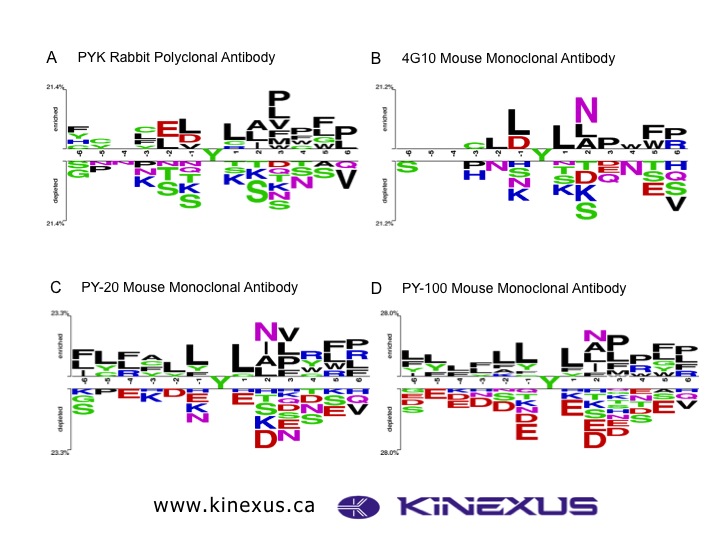Product Name: PYK
Product Number: AB-PG001
| Size: | 25 µg | Price: | 89.00 | |
| $US |
Product Type Specific: Generic phosphotyrosine-specific antibody
Antibody Code: PG001
Antibody Target Type: Generic phosphotyrosine-specific
Antibody Phosphosite: Generic phospho
Antibody Type: Polyclonal
Antibody Host Species: Rabbit
Antibody Immunogen Source: Over 200 diverse phosphotyrosine phosphorylation site peptides
Antibody Immunogen Description: Diverse locations
Antibody Code: PG001
Antibody Target Type: Generic phosphotyrosine-specific
Antibody Phosphosite: Generic phospho
Antibody Type: Polyclonal
Antibody Host Species: Rabbit
Antibody Immunogen Source: Over 200 diverse phosphotyrosine phosphorylation site peptides
Antibody Immunogen Description: Diverse locations
Production Method: Over 400 immunizing phosphopeptides were produced by solid phase synthesis on a multipep peptide synthesizer and purified by reverse-phase hplc chromatography. Purities were assessed by analytical hplc and the amino acid sequences confirmed by mass spectrometry analysis. These peptides were coupled to KLH prior to immunization into rabbits. New Zealand White rabbits were subcutaneously injected with KLH-coupled immunizing peptide every 4 weeks for 4 months. The sera from these animals was applied onto agarose columns to which a phosphotyrosine-beta-alanine-cysteine was thio-linked. Antibody was eluted from the column with 0.1 M glycine, pH 2.5. Subsequently, the antibody solution was neutralized to pH 7.0 with saturated Tris.
Antibody Modification: Unconjugated. Contact KInexus if you are interest in having the antibody biotinylated or coupled with fluorescent dyes.
Antibody Concentration: 1 mg/ml
Antibody Modification: Unconjugated. Contact KInexus if you are interest in having the antibody biotinylated or coupled with fluorescent dyes.
Antibody Concentration: 1 mg/ml
Storage Buffer: Phosphate buffered saline pH 7.4, 0.05% Thimerasol
Storage Conditions: For long term storage, keep frozen at -40°C or lower. Stock solution can be kept at +4°C for more than 3 months. Avoid repeated freeze-thaw cycles.
Product Use: Western blotting | Antibody microarray
Antibody Dilution Recommended: 2 µg/ml for immunoblotting
Antibody Species Reactivity: Human
Related Product 1: PYK-Ultra generic phosphotyrosine-specific antibody (Cat. No.: AB-PG001U)
Related Product 2: Phosphotyrosine pan-specific antibody (Cat. No.: AB-CN005-2)
Related Product 3: PYKSD8 generic phospho-specific antibody (Cat. No.: AB-PG005)
Storage Conditions: For long term storage, keep frozen at -40°C or lower. Stock solution can be kept at +4°C for more than 3 months. Avoid repeated freeze-thaw cycles.
Product Use: Western blotting | Antibody microarray
Antibody Dilution Recommended: 2 µg/ml for immunoblotting
Antibody Species Reactivity: Human
Related Product 1: PYK-Ultra generic phosphotyrosine-specific antibody (Cat. No.: AB-PG001U)
Related Product 2: Phosphotyrosine pan-specific antibody (Cat. No.: AB-CN005-2)
Related Product 3: PYKSD8 generic phospho-specific antibody (Cat. No.: AB-PG005)
Table 1. Immunoreactivities of generic phosphotyrosine-specific antibodies with the 6099 tyrosine-phosphorylated peptides on the Jerini JPT Phosphatase Peptide Microarray and ~500 phosphopeptides on the Kinex™ (KPSM) Phosphopeptide Microarray.
Figure 2. Phosphoamino acid specificity of ~2 µg/ml PYK, ~5 µg/ml 4G10, ~5 µg/ml PY-20, and ~1 µg/ml PY-100 with 500 phosphopeptides on the Kinex™ (KPSM) Phosphopeptide Microarray. The peptide signals (normalized to median value) for each antibody and type of phosphorylated peptide were sorted in order of the strongest signal first.
Figure 3. Phosphotyrosine peptide reactivity of ~2 µg/ml PYK, ~5 µg/ml 4G10, ~5 µg/ml PY-20, and ~1 µg/ml PY-100 for 6099 phosphotyrosine-containing peptides on the Jerini JPT Phosphatase Peptide Microarray. The peptide signals (normalized to median value) for each antibody were sorted in order of the strongest signal first.
Figure 3. VENN diagram of the 1746 most immunoreactive phosphotyrosine-containing peptides on the Jerini JPT Phosphatase Peptide Microarray with PYK (1316; 75.4%), 4G10 (1,168; 66.9%), PY-20 (1,193; 68.3%) and PY-100 (1,307; 74.9%).
Table 2. Frequency of amino acids surrounding 34,004 experimentally confirmed human phosphosites from data collected from PhosphoNET (www.phosphonet.ca). Note the high occurrence of acidic amino acids.
Table 3. Flanking amino acid specificities of generic phosphotyrosine-specific antibodies. It is evident that 4G10, PY-20 and PY-100, but not PYK, exhibit a bias against detection of tyrosine phosphorylation sites that are flanked by acidic amino acids.
Figure 4. Logo diagram for amino acid specificity preferences of generic phosphotyrosine-specific antibodies.
Figure 5. Immunoreactivities of PYK (~2 µg/ml) and 4G10 (~5 µg/ml) phosphotyrosine-specific antibodies with A431 cervical carcinoma cells, HCT-116 colon carcinoma cells, HeLa cervical carcinoma cells, and Jurkat T-cells.
Figure 6. Immunoreactivities of PYK (~2 µg/ml), 4G10 (~5 µg/ml), PY-20 (~5 µg/ml), and PY-100 (2 µg/ml) generic phosphotyrosine-specific antibodies with lysates from A431 cervical carcinoma cells treated with the protein phosphatase inhibitors phenylarsine oxide (PAO) and Na3VO4 as well as epidermal growth factor.
© Kinexus Bioinformatics Corporation 2017










